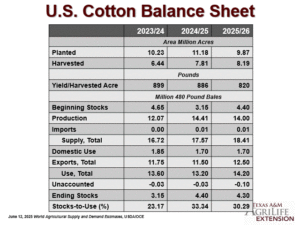Fundamental analysis involves comparing major supply and demand variables like production, consumption, and ending stocks. This is usually based on organized tables, the prime example of which are published by USDA, and reproduced below:
Updated world cotton supply/demand. USDA’s month-over-month adjustments in the June WASDE report reflected bullish adjustments to 2024/25 world cotton balance sheet. The main adjustment was a 1.1 million bale decrease in world production, dominating smaller and mostly offsetting adjustments to world consumption (-130,000 bales) and world exports (+160,000 bales). The bottom line was a 1.1 million bale decrease in old crop world ending stocks, which would be historically price supportive.
Updated U.S. cotton supply/demand. The June WASDE saw bullish month-over-month adjustments to the U.S. balance sheet. Supply side variables were unchanged, which is not surprising this late in the marketing year. On the demand side, U.S. exports was raised 400,000 bales, which went straight to the bottom line of 400,000 fewer bales of ending stocks, month over month. This is both bullish in the adjustment, and leaves U.S. ending stocks at a less bearish 4.4 million bales.
Fundamental analysis is fairly straightforward in its application. However, there are a lot of moving parts and uncertainty in balancing supply and demand variables. The price outlook can also be influenced by non-fundamental factors, particularly in the short run.
